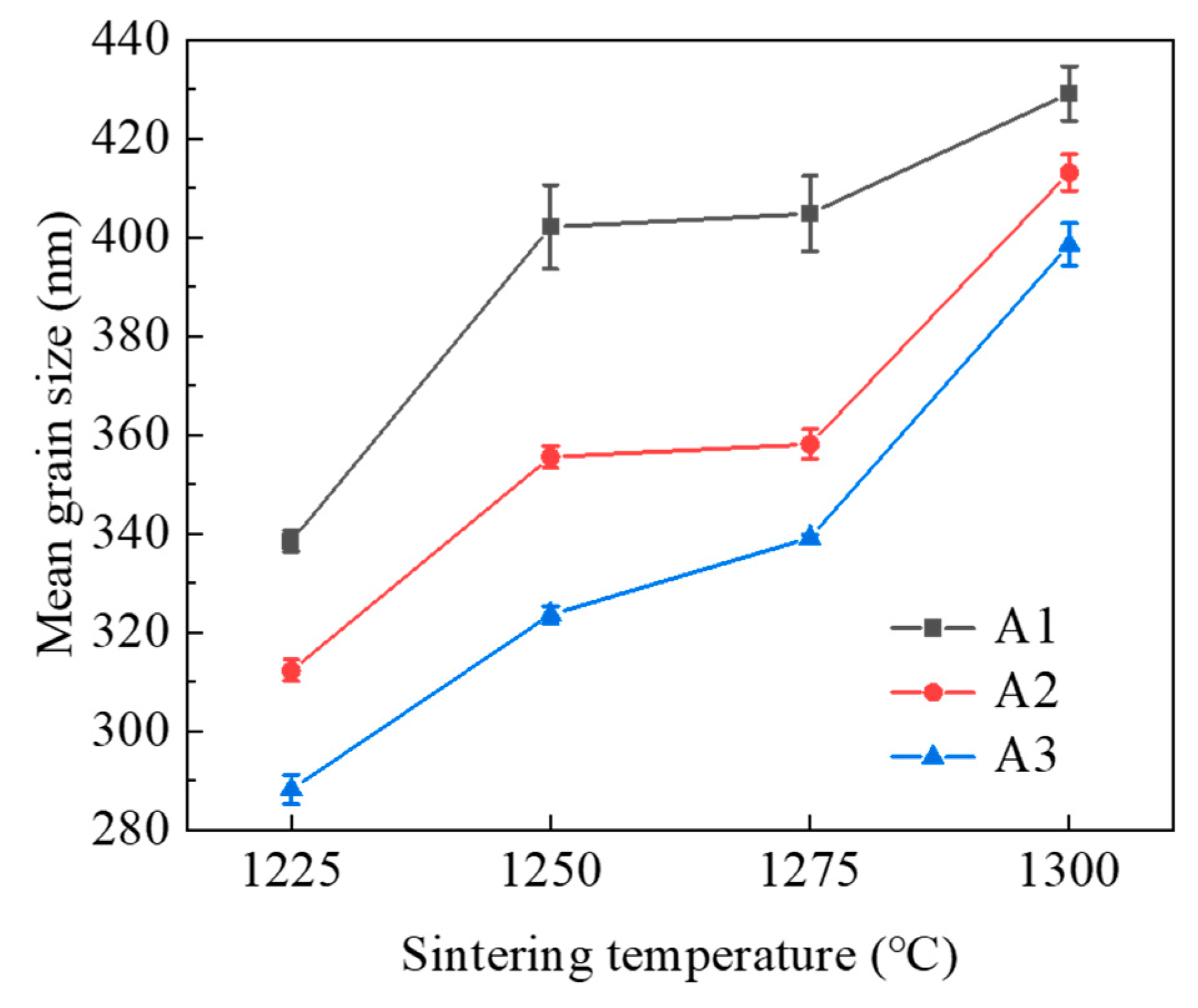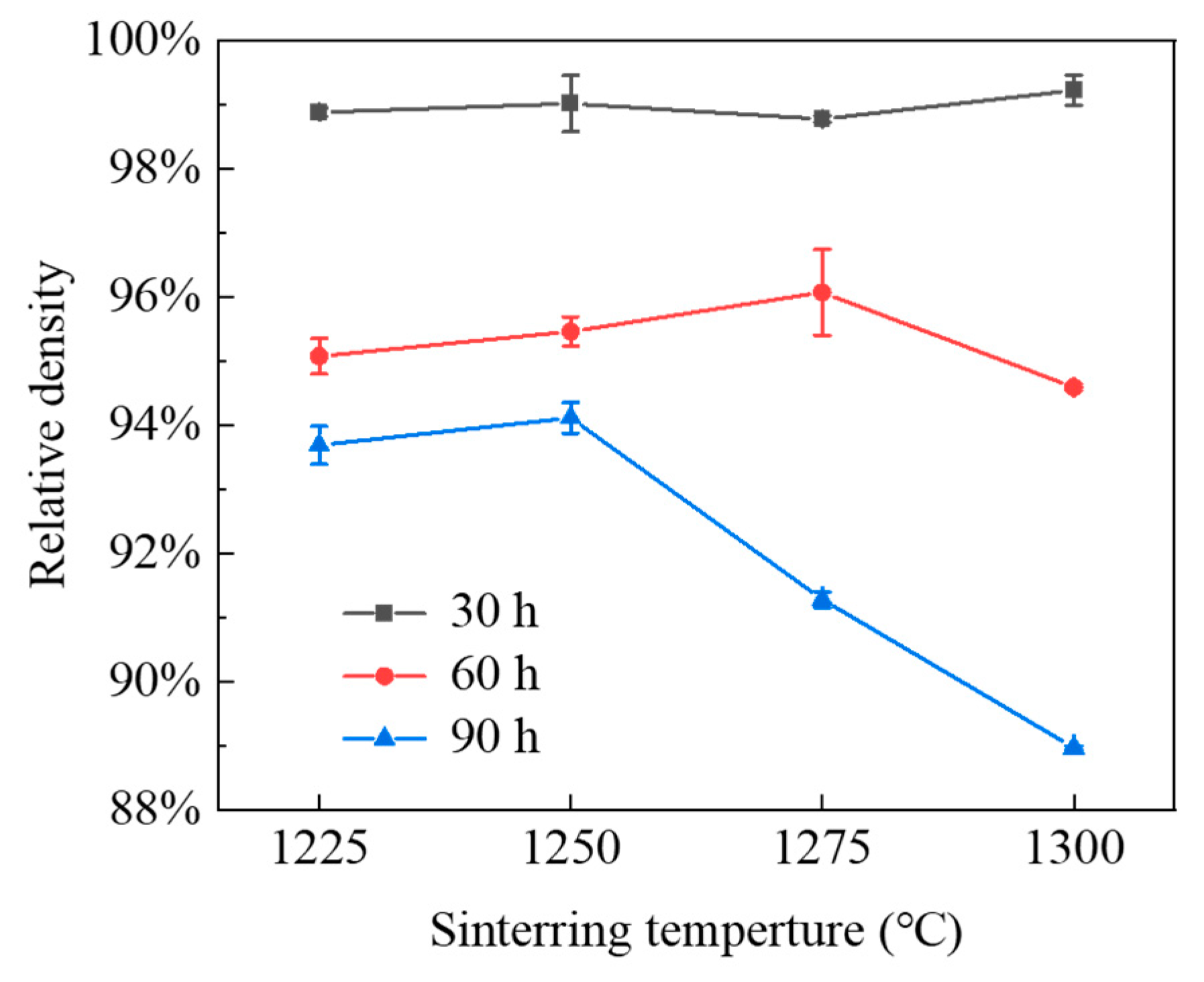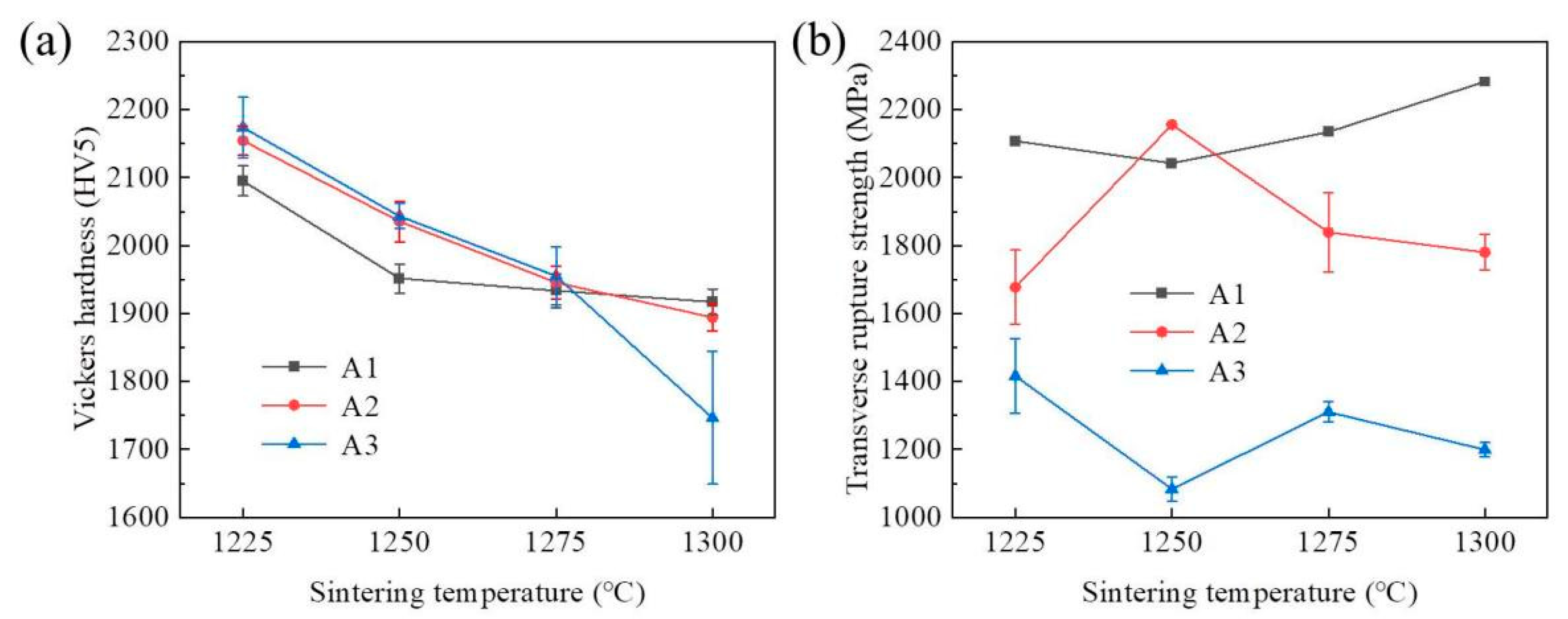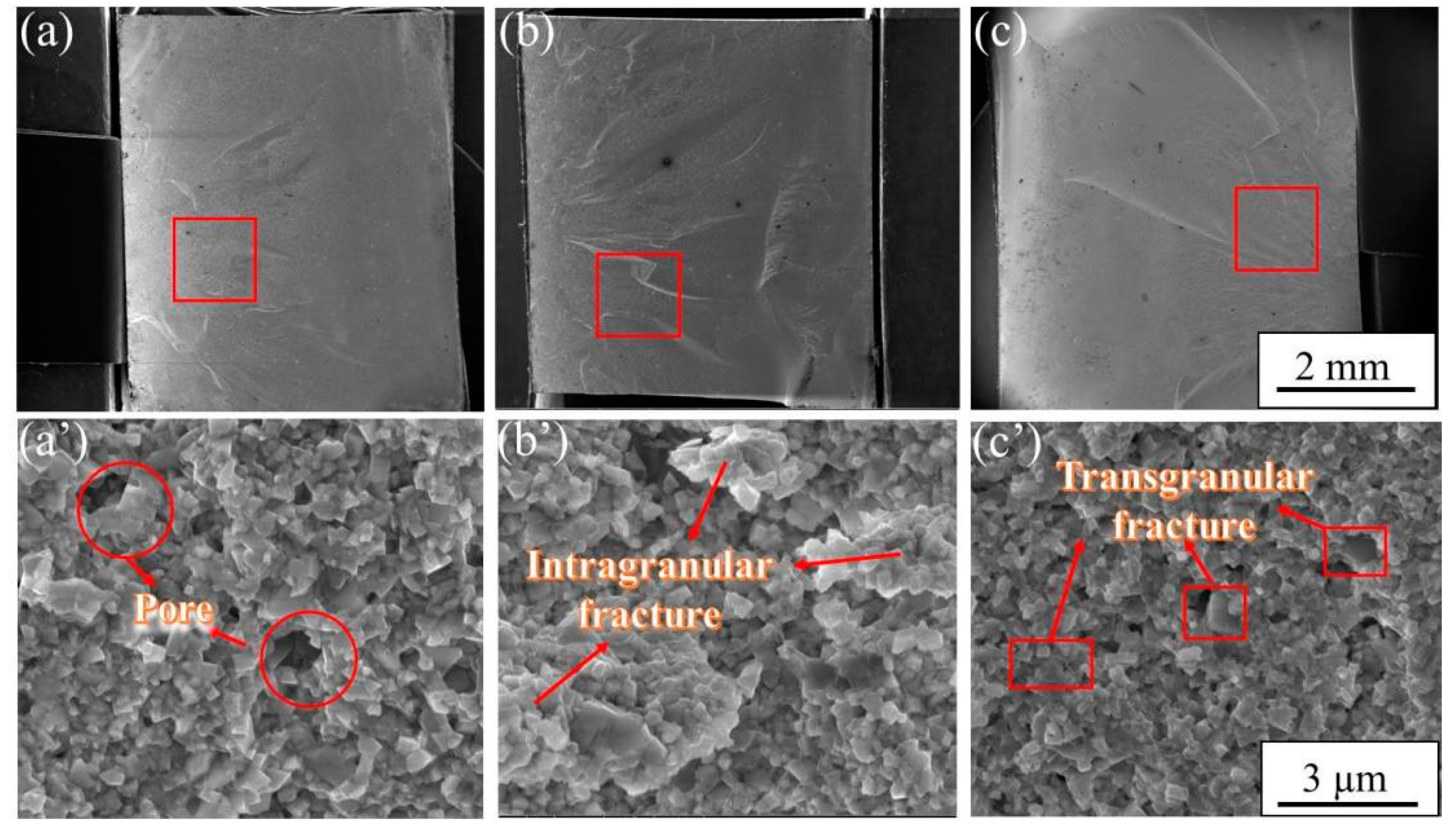Effects of Processing Parameters on the Microstructure and Mechanical Properties of Nanoscaled WC-10Co Cemented Carbide
Abstract
:1. Introduction
2. Experiment
3. Results and Discussion
3.1. Microstructure and Phase Constitution Analysis
3.2. Impact of Processing Parameters on Mechanical Properties
4. Conclusions
- (1)
- The average grain size of WC-Co cemented carbide decreased with the increase in ball-milling time and coarsened with the increase in sintering temperature. The finest grain size of 288.22 nm was obtained after 90 h of ball milling and at a 1225 °C sintering temperature.
- (2)
- Due to the Hall–Petch relationship, the hardness of sintered samples showed an opposite trend with the change of grain size, increasing with the decrease in grain size. The highest hardness of 2173.831 kg/mm2 was obtained after ball milling for 90 h and sintering at 1225 °C.
- (3)
- With the increase in ball-milling time, the degree of the breakage and refinement of the WC particles was intensified. After 90 h, these refined WC particles agglomerated, which were unstable wen matching with the matrix. In turn, the relative density decreased and the hardness sharply dropped to 1746.25 kg/mm2 at 1300 °C. The results showed that the effect of relative density on hardness was greater than that of grain size.
- (4)
- Compared to the results under ball-milling times of 30 h and 60 h, the grain size after 90 h was smaller, the eutectic temperature was the lowest, and the loss of Co was greater, thus resulting in the lowest TRS value.
- (5)
- After 90 h of ball milling, there were obvious pores in the crack growth zone and the crack source was formed, which seriously endangered the mechanical properties. Furthermore, the increasing degree of transformation from α-Co to ε-Co and the increasing number of WC/WC interfaces also endangered the TRS of cemented carbide.
Author Contributions
Funding
Informed Consent Statement
Data Availability Statement
Conflicts of Interest
References
- Jia, C.; Sun, L.; Tang, H.; Qu, X. Hot pressing of nanometer WC–Co powder. Int. J. Refract. Met. Hard Mater. 2007, 25, 53–56. [Google Scholar]
- El-Eskandarany, M.S.; Mahday, A.A.; Ahmed, H.A.; Amer, A.H. Synthesis and Characterizations of Ball-Milled Nanocrystalline WC and Nanocomposite WC–Co Powders and Subsequent Consolidations. J. Alloys Compd. 2000, 312, 315–325. [Google Scholar]
- Fang, Z.Z.; Wang, X.; Ryu, T.; Hwang, K.S.; Sohn, H.Y. Synthesis, sintering, and mechanical properties of nanocrystalline cemented tungsten carbide—A review. Int. J. Refract. Met. Hard Mater. 2009, 27, 288–299. [Google Scholar]
- Ke, Z.; Zheng, Y.; Zhang, G.; Zhang, J.; Wu, H.; Xu, X.; Zhu, X. Microstructure and mechanical properties of WC-(Ti,W)C-Co hardmetals fabricated by in-situ carbothermal reduction of oxides and subsequent liquid phase sintering. J. Alloys Compd. 2021, 865, 158897. [Google Scholar]
- Wohaibi, S.; Mohammed, A.; Laoui, T.; Hakeem, A.S.; Adesina, A.Y.; Patel, F. Tribological Characterization of Micron-/Nano-Sized WC-9%Co Cemented Carbides Prepared by Spark Plasma Sintering at Elevated Temperatures. Materials 2019, 12, 920. [Google Scholar]
- Chen, H.; Yang, Q.; Yang, J.; Yang, H.; Chen, L.; Ruan, J.; Huang, Q. Effects of VC/Cr 3 C 2 on WC grain morphologies and mechanical properties of WC-6wt.%Co cemented carbides. J. Alloys Compd. 2017, 714, 245–250. [Google Scholar] [CrossRef]
- Farag, S.; Konyashin, I.; Ries, B. The influence of grain growth inhibitors on the microstructure and properties of submicron, ultrafine and nano-structured hardmetals—A review. Int. J. Refract. Met. Hard Mater. 2018, 77, 12–30. [Google Scholar] [CrossRef]
- Christensen, M.; Wahnström, G.; Lay, S.; Allibert, C.H. Morphology of WC grains in WC–Co alloys: Theoretical determination of grain shape. Acta Mater. 2007, 55, 1515–1521. [Google Scholar]
- Lin, N.; He, Y.; Wu, C.; Jiang, Y. Influence of copper content on the microstructure and hardness of copper-doped tungsten car-bide-cobalt bulk at the elevated temperature. Int. J. Refract. Met. Hard Mater. 2013, 38, 140–143. [Google Scholar]
- Morton, C.W.; Wills, D.J.; Stjernberg, K. The temperature ranges for maximum effectiveness of grain growth inhibitors in WC–Co alloys. Int. J. Refract. Met. Hard Mater. 2005, 23, 287–293. [Google Scholar]
- Luo, R.; Chen, N.; Xiong, H.; Li, Z. Microhomogeneous WC-TiC-Co composite powders with enhanced sinterability via a two-step carburization method. Int. J. Refract. Met. Hard Mater. 2021, 95, 105413. [Google Scholar]
- Wang, H.; Webb, T.; Bitler, J.W. Different effects of Cr3C2 and VC on the sintering behavior of WC–Co materials. Int. J. Refract. Met. Hard Mater. 2015, 53, 117–122. [Google Scholar]
- Wei, C.B.; Song, X.Y.; Fu, J.; Liu, X.M.; Gao, Y.; Wang, H.B.; Zhao, S.X. Microstructure and properties of ultrafine cemented carbides—Differences in spark plasma sintering and sinter-HIP. Mater. Sci. Eng. A 2012, 552, 427–433. [Google Scholar]
- Sun, L.; Jia, C.-C.; Xian, M. A research on the grain growth of WC–Co cemented carbide. Int. J. Refract. Met. Hard Mater. 2007, 25, 121–124. [Google Scholar]
- Sugiyama, I.; Mizumukai, Y.; Taniuchi, T.; Okada, K.; Shirase, F.; Tanase, T.; Ikuhara, Y.; Yamamoto, T. Three-dimensional morphology of (W,V)Cx in VC-doped WC–Co hard metals. Scripta Mater. 2013, 69, 473–476. [Google Scholar]
- Liu, X.; Song, X.; Wang, H.; Liu, X.; Wang, X.; Guo, G. Preparation and mechanisms of cemented carbides with ultrahigh fracture strength. J. Appl. Crystallogr. 2015, 48, 1254–1263. [Google Scholar]
- Liu, X.; Song, X.; Wang, H.; Hou, C.; Liu, X.; Wang, X. Reinforcement of tungsten carbide grains by nanoprecipitates in cemented carbides. Nanotechnology 2016, 27, 415710. [Google Scholar]
- Delanoë, A.; Bacia, M.; Pauty, E.; Lay, S.; Allibert, C.H. Cr-rich layer at the WC/Co interface in Cr-doped WC–Co cements: Segregation or metastable carbide? J. Crystal Growth 2004, 270, 219–227. [Google Scholar]
- Sun, L.; Yang, T.; Jia, C.; Xiong, J. VC, Cr3C2 doped ultrafine WC–Co cemented carbides prepared by spark plasma sintering. Int. J. Refract. Met. Hard Mater. 2011, 29, 147–152. [Google Scholar]
- Liu, K.; Wang, Z.; Yin, Z.; Cao, L.; Yuan, J. Effect of Co content on microstructure and mechanical properties of ultrafine grained WC-Co cemented carbide sintered by spark plasma sintering. Ceram. Int. 2018, 44, 18711–18718. [Google Scholar]
- Garbiec, D.; Siwak, P. Microstructural evolution and development of mechanical properties of spark plasma sintered WC-Co cemented carbides for machine parts and engineering tools. Arch. Civ. Mech. Eng. 2019, 19, 215–223. [Google Scholar]
- Liu, X.; Song, X.; Zhang, J.; Zhao, S. Temperature distribution and neck formation of WC–Co combined particles during spark plasma sintering. Mater. Sci. Eng. A 2008, 488, 1–7. [Google Scholar]
- Huang, S.G.; Li, L.; Vanmeensel, K.; Van der Biest, O.; Vleugels, J. VC, Cr3C2 and NbC doped WC–Co cemented carbides prepared by pulsed electric current sintering. Int. J. Refract. Met. Hard Mater. 2007, 25, 417–422. [Google Scholar]
- Hewitt, S.A.; Kibble, K.A. Effects of ball milling time on the synthesis and consolidation of nanostructured WC–Co composites. Int. J. Refract. Met. Hard Mater. 2009, 27, 937–948. [Google Scholar]
- Su, W.; Huang, Z.; Ren, X.; Chen, H.; Ruan, J. Investigation on morphology evolution of coarse grained WC–6Co cemented carbides fabricated by ball milling route and hydrogen reduction route. Int. J. Refract. Met. Hard Mater. 2016, 56, 110–117. [Google Scholar]
- Mandel, K.; Krüger, L.; Schimpf, C. Particle properties of submicron-sized WC–12Co processed by planetary ball milling. Int. J. Refract. Met. Hard Mater. 2014, 42, 200–204. [Google Scholar]
- Wang, B.; Wang, Z.; Yin, Z.; Liu, K.; Yuan, J. Effects of powder preparation and sintering temperature on consolidation of ultrafine WC-8Co tool material produced by spark plasma sintering. Ceram. Int. 2019, 45, 19737–19746. [Google Scholar]
- Sun, J.; Zhang, F.; Shen, J. Characterizations of ball-milled nanocrystalline WC–Co composite powders and subsequently rapid hot pressing sintered cermets. Mater. Lett. 2003, 57, 3140–3148. [Google Scholar]
- Kim, J.; Suh, Y.J.; Kang, I. First-principles calculations of the phase stability and the elastic and mechanical properties of η-phases in the WC–Co system. J. Alloys Compd. 2016, 656, 213–217. [Google Scholar]
- Marshall, J.M.; Giraudel, M. The role of tungsten in the Co binder: Effects on WC grain size and hcp–fcc Co in the binder phase. Int. J. Refract. Met. Hard Mater. 2015, 49, 57–66. [Google Scholar]
- Zhao, Z. Microwave-assisted synthesis of vanadium and chromium carbides nanocomposite and its effect on properties of WC-8Co cemented carbides. Scripta Mater. 2016, 120, 103–106. [Google Scholar]
- Bonache, V.; Salvador, M.D.; Rocha, V.G.; Borrell, A. Microstructural control of ultrafine and nanocrystalline WC–12Co–VC/Cr3C2 mixture by spark plasma sintering. Ceram. Int. 2011, 37, 1139–1142. [Google Scholar]
- Enayati, M.H.; Aryanpour, G.R.; Ebnonnasir, A. Production of nanostructured WC–Co powder by ball milling. Int. J. Refract. Met. Hard Mater. 2009, 27, 159–163. [Google Scholar]
- Yang, Q.; Yang, J.; Yang, H.; Ruan, J. The effects of fine WC contents and temperature on the microstructure and mechanical properties of inhomogeneous WC-(fine WC-Co) cemented carbides. Ceram. Int. 2016, 42, 18100–18107. [Google Scholar]
- Liu, C.; Lin, N.; He, Y.; Wu, C.; Jiang, Y. The effects of micron WC contents on the microstructure and mechanical properties of ul-trafine WC–(micron WC–Co) cemented carbides. J. Alloys Compd. 2014, 594, 76–81. [Google Scholar]
- Chang, S.-H.; Chen, S.-L. Characterization and properties of sintered WC–Co and WC–Ni–Fe hard metal alloys. J. Alloys Compd. 2014, 585, 407–413. [Google Scholar]
- Su, W.; Sun, Y.; Wang, H.; Zhang, X.; Ruan, J. Preparation and sintering of WC–Co composite powders for coarse grained WC–8Co hardmetals. Int. J. Refract. Met. Hard Mater. 2014, 45, 80–85. [Google Scholar]
- Xiao, D.-h.; Zhang, F.-q.; Luo, W.-h. Fabrication and characterization of ultrafine WC–8Co–xCeB6 cemented carbides. Ceram. Int. 2011, 37, 2795–2801. [Google Scholar]
- Wang, B.; Jia, J.; Wang, Z.; Yin, Z.; Huang, L.; Yuan, J. Fabrication and performance of graded ultrafine WC–Co cemented carbide tool by one/two-step spark plasma sintering. Ceram. Int. 2021, 47, 8322–8329. [Google Scholar]








| Symbol | Ball-Milling Time/h | Rotation Speed/rpm |
|---|---|---|
| A1 | 30 | 150 |
| A2 | 60 | 150 |
| A3 | 90 | 150 |
Publisher’s Note: MDPI stays neutral with regard to jurisdictional claims in published maps and institutional affiliations. |
© 2022 by the authors. Licensee MDPI, Basel, Switzerland. This article is an open access article distributed under the terms and conditions of the Creative Commons Attribution (CC BY) license (https://creativecommons.org/licenses/by/4.0/).
Share and Cite
Wang, Y.; Xiang, F.; Yuan, X.; Yang, B.; Wang, F.; Li, Y. Effects of Processing Parameters on the Microstructure and Mechanical Properties of Nanoscaled WC-10Co Cemented Carbide. Materials 2022, 15, 4472. https://doi.org/10.3390/ma15134472
Wang Y, Xiang F, Yuan X, Yang B, Wang F, Li Y. Effects of Processing Parameters on the Microstructure and Mechanical Properties of Nanoscaled WC-10Co Cemented Carbide. Materials. 2022; 15(13):4472. https://doi.org/10.3390/ma15134472
Chicago/Turabian StyleWang, Yu, Fengming Xiang, Xiaobo Yuan, Biaobiao Yang, Fenglin Wang, and Yunping Li. 2022. "Effects of Processing Parameters on the Microstructure and Mechanical Properties of Nanoscaled WC-10Co Cemented Carbide" Materials 15, no. 13: 4472. https://doi.org/10.3390/ma15134472





